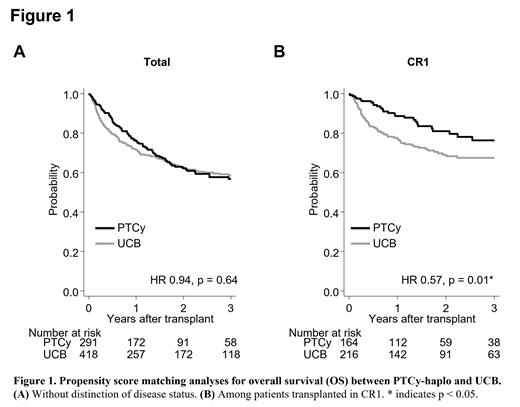[Introduction]
HLA-haploidentical stem cell transplantation using post-transplant cyclophosphamide (PTCy-haplo) and umbilical cord blood transplantation (UCB) are alternative to HLA-matched hematopoietic stem cell transplantation (HSCT). However, advantage of PTCy-haplo versus UCB has not been determined in patients with acute lymphoblastic leukemia (ALL). Thus, we compared post-HSCT outcomes of PTCy-haplo and UCB in adult patients with ALL to determine patient subgroups who benefit from PTCy-haplo.
[Methods]
We analyzed data on adult patients (≥16 years) with ALL who underwent HSCT with PTCy-haplo or single-unit UCB between January 2013 and December 2021, using the Japanese nationwide registry database. Endpoints of the analysis included overall survival (OS), disease-free survival (DFS), cumulative incidence of relapse, non-relapse mortality (NRM), engraftments, acute and chronic graft-versus-host disease (GVHD), and infections. In addition to multivariate analysis, propensity score matching was performed as a sensitivity analysis.
[Results]
We analyzed 1999 patients (PTCy-haplo, 330; UCB, 1669). Median age at HSCT was 44.5 years (range, 16-73) in PTCy-haplo and 45 years (range, 16-74) in UCB group. The proportion of patients who underwent HSCT in the first complete remission (CR1) (PTCy-haplo, 50.3%; UCB, 48.8%) and median time from diagnosis to HSCT (PTCy-haplo, 7.8 months; UCB, 7.7 months) were comparable between the groups. Regarding conditioning, the proportion of those who received myeloablative conditioning (PTCy-haplo, 50.6%; UCB, 54.8%), or conditioning with total body irradiation (PTCy-haplo, 82.4%; UCB, 79.3%) were comparable between the groups.
Multivariate analyses showed that PTCy-haplo recipients had comparable 3-year OS (54.1% vs. 52.3%; adjusted hazard ratio [aHR], 0.93; p = 0.51) and DFS (49.7% vs. 47.1%; aHR, 1.06; p = 0.60) with UCB recipients. PTCy-haplo recipients had a significantly higher 3-year relapse rate (32.2% vs. 26.4%; aHR, 1.47; p = 0.01), but had a significantly lower 3 -year NRM (18.1% vs. 26.5%; aHR, 0.70; p = 0.03) as compared to UCB along with significantly faster neutrophil (median, 16 days vs. 20 days) and platelet (median, 30 days vs. 42 days) engraftments, and lower incidence of viral, fungal and bacterial infections. There was no significant difference in cumulative incidence of acute GVHD (30.9% vs. 36.4%, grade II-IV at 100 days; p = 0.15), or chronic GVHD (22.5% vs. 20.9% at 3 years; p = 0.85) between the two groups. These comparable OS and DFS between the two groups were confirmed after minimizing differences in patient characteristics with propensity score matching analysis (Figure 1A).
Then, to identify patient subgroups who benefit from PTCy-haplo rather than UCB transplant, we performed subgroup analyses of OS. Significantly favorable effects of PTCy-haplo over UCB were observed in patients with CR1 at HSCT (HR, 0.66; p = 0.03). Indeed, propensity score matching analysis showed that PTCy-haplo recipients had a significantly higher 3-year OS (76.4% vs. 67.6%; HR, 0.57; p = 0.01) and DFS (70.5% vs. 60.6%; HR, 0.66; p = 0.03) than UCB recipients, along with a significantly lower NRM (12.9% vs. 26.3%; HR, 0.39; p < 0.01), and a comparable relapse rate (16.6% vs. 13.1%; HR, 1.41; p = 0.25) with UCB. These results suggest that the low NRM in PTCy-haplo transplant outweighs potential concerns of relapse among patients transplanted in CR1 (Figure 1B). By contrast, in patients with ≥ 2 nd CR or non-CR at HSCT, survival benefits of PTCy-haplo were not observed.
[Conclusions]
Our results suggest that while both PTCy-haplo and UCB are suitable alternative donor sources for adult ALL patients without HLA-matched donors, in patients with CR1, selection of PTCy-haplo rather than UCB improves post-transplant prognosis.
Disclosures
Kondo:Asahi Kasei Pharmaceutica,Chugai Pharma, MSD Pharmaceutical, Dainippon Sumitomo Pharma, Otsuka Pharmaceutical: Honoraria, Research Funding. Tanaka:Asahi Kasei Pharma: Speakers Bureau; Otsuka Pharmaceutical: Speakers Bureau; MSD: Speakers Bureau; Kyowa-Kirin: Speakers Bureau; Daiichi Sankyo: Speakers Bureau; Astellas Phrama: Speakers Bureau; Chugai Pharmaceutical: Speakers Bureau; Abbvie: Speakers Bureau; Sumitomo Pharma: Speakers Bureau; Pfizer: Speakers Bureau. Nakamae:Takeda Pharmaceutical Company: Honoraria; Novartis: Research Funding; Parexel International Inc: Research Funding; CMIC Company: Research Funding; Alexion Pharma: Research Funding; Meiji Seika Pharma: Research Funding; DAIICHI SANKYO COMPANY: Honoraria; Janssen Pharmaceutical K.K.: Honoraria; Nihon Shinyaku: Honoraria; Sumitomo Dainippon Pharma: Honoraria; Bristol-Myers Squibb: Research Funding; Amgen: Honoraria; Otsuka: Honoraria; Abbvie: Honoraria; Astellas: Honoraria. Doki:Novartis Pharma K.K.: Honoraria; Janssen Pharmaceutical K.K.: Honoraria. Ota:Amgen: Speakers Bureau; Bristol Myers Squibb: Speakers Bureau; Novartis: Speakers Bureau; AstraZeneca: Speakers Bureau; Janssen: Speakers Bureau. Sawa:Janssen: Honoraria; Sanofi: Honoraria. Takayama:Kyowa Kirin: Honoraria, Research Funding; Chugai Pharma: Honoraria, Research Funding; Takeda: Honoraria, Research Funding; Asahi Kasei: Honoraria, Research Funding; Eisai: Honoraria; SymBio Pharmaceuticals: Honoraria; Celgene: Honoraria; Nippon Shinyaku: Honoraria; Janssen Pharmaceutical: Honoraria; Bristol Myers Squibb: Honoraria. Kanda:Eisai: Research Funding, Speakers Bureau; AbbVie: Research Funding, Speakers Bureau; CSL Behring: Speakers Bureau; Japan Blood Products Organization: Research Funding, Speakers Bureau; Otsuka Pharmaceutical: Research Funding, Speakers Bureau; AstraZeneca: Speakers Bureau; Human Life CORD: Speakers Bureau; Sumitomo Pharma: Research Funding, Speakers Bureau; Amgen: Speakers Bureau; Takeda Pharmaceutical: Research Funding, Speakers Bureau; Meiji Seika Pharma: Speakers Bureau; Asahi Kasei Pharma: Research Funding, Speakers Bureau; Daiichi Sankyo: Research Funding, Speakers Bureau; Saitama Hokeni Kyokai: Speakers Bureau; MSD: Speakers Bureau; Kyowa Kirin: Research Funding, Speakers Bureau; Janssen Pharmaceutical: Speakers Bureau; Sanofi: Speakers Bureau; Pfizer: Speakers Bureau; Chugai Pharmaceutical: Research Funding, Speakers Bureau; Novartis: Speakers Bureau; Bristol Myers Squibb: Speakers Bureau; Towa Pharma: Speakers Bureau; FUJIFILM Wako Pure Chemical: Speakers Bureau; Alexion Pharma: Speakers Bureau; Precision: Speakers Bureau; Nippon Shinyaku: Speakers Bureau; Wakunaga Pharmaceutical: Speakers Bureau; Shionogi Pharma: Research Funding; Taiho Pharmaceutical: Research Funding; Nippon Kayaku: Research Funding; JCR Pharmaceuticals: Research Funding. Ichinohe:Repertoire Genesis Inc.: Research Funding; Chugai Pharmaceutical Co.: Research Funding; Kyowa Kirin Co.: Research Funding; Takeda Pharmaceutical Co.: Research Funding; Ono Pharmaceutical Co.: Research Funding; Nippon Shinyaku Co.: Research Funding. Atsuta:CHUGAI PHARMACEUTICAL CO., LTD.: Speakers Bureau; Otsuka Pharmaceutical Co., Ltd: Speakers Bureau; Meiji Seika Pharma Co, Ltd.: Honoraria; JCR Pharmaceuticals Co., Ltd.: Consultancy; Novartis Pharma KK: Speakers Bureau.


This feature is available to Subscribers Only
Sign In or Create an Account Close Modal